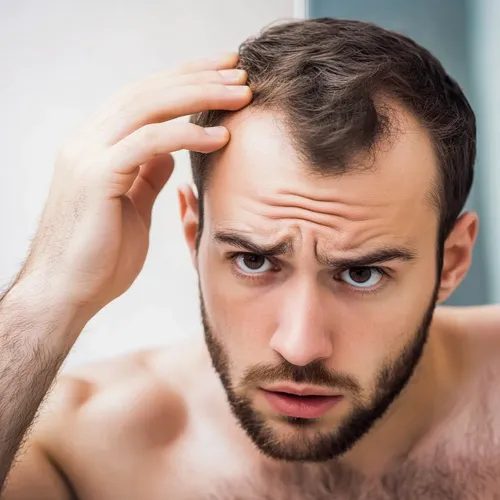What’s the Deal with Hair, Anyway?
Ever wonder what’s growing out of your scalp? It’s not just dead cells, folks – it’s a protein powerhouse called keratin. Your noggin’s sporting anywhere from 100,000 to 150,000 of these protein strings, each nestled in its own little follicle. And get this – you’re shedding up to 100 hairs a day without even noticing! Don’t panic, though. Your body’s usually got your back, growing new strands to replace the ones you’ve lost.
But here’s the kicker: as we age, our hair growth slows down. By 50, a whopping 85% of men will start seeing their locks thin out. Ladies aren’t off the hook either – half of women will be dealing with female-pattern baldness by 65. It’s not just Father Time to blame, though. A whole host of factors can trigger hair loss in both sexes.
The Many Faces of Hair Loss
Hair loss, or alopecia if you want to get fancy, comes in more flavors than your local ice cream shop. Let’s break it down:
- Involutional alopecia: The natural thinning that comes with age. Your hair’s like, “I’m tired, boss. Time to slow down.”
- Androgenic alopecia: The genetic troublemaker causing pattern baldness in both men and women.
- Alopecia areata: The sneaky one that causes patchy baldness, often in youngsters. Don’t worry, though – the hair usually makes a comeback.
- Alopecia barbae: When your beard decides to take an unscheduled vacation.
- Alopecia universalis: The overachiever that makes ALL your body hair fall out.
- Trichotillomania: When your own mind becomes your hair’s worst enemy, causing you to pull it out.
- Telogen effluvium: The drama queen of hair loss, triggered by stress or sudden events.
- Traction alopecia: When your hairstyle turns traitor. Those tight ponytails might look fierce, but they’re secretly plotting against your hairline.
- Anagen effluvium: The collateral damage of cancer treatments.
- Scarring alopecias: When skin conditions leave lasting scars, kicking hair follicles out of their homes for good.
What’s Behind the Vanishing Act?
Your hair’s got its own life cycle, influenced by a motley crew of factors: age, genes, hormones, disease, and injury. But let’s face it – for most folks, it’s the genetic lottery that determines whether you’ll be rocking a full head of hair or sporting the chrome dome look.
For guys, hair loss can start as early as their late teens. It usually kicks off with a receding hairline, then moves on to thinning around the crown and frontal scalp. Before you know it, those areas might be as bare as a baby’s bottom.
Ladies usually don’t start this follicular fun until their 40s. For them, it’s more of an all-over thinning situation, with the crown often taking the biggest hit.
But wait, there’s more! Sudden hair loss could be your body’s way of waving a red flag. It might be signaling:
- A thyroid tantrum
- Diabetes drama
- Lupus lurking
- Anaemia antics
- Cancer treatments
- Medicine side effects
- Vitamin A overdose
- Iron deficiency
- Hormonal hullabaloo
- Scalp infections
- Stress overload
- Overzealous styling
The silver lining? Most sudden hair loss is just a temporary setback. Once you tackle the root cause (pun intended), your hair should make a triumphant return.
When to Call in the Pros
While a receding hairline isn’t usually a medical emergency, it’s been linked to some serious health issues like heart disease, prostate problems, diabetes, obesity, and high blood pressure. So, keep an eye out!
If your hair starts jumping ship suddenly, you’re developing bald patches, losing hair in clumps, or your scalp’s itching and burning like crazy – it’s time to ring up your GP. They can help you get to the root of the problem and point you towards treatment options.
Remember, there’s no shame in seeking help if hair loss is messing with your mojo. Your doc can hook you up with treatments and support to help you through this hairy situation.
Treating the Follicular Fallout
Now, here’s the cold, hard truth: there’s no magic bullet for male and female pattern baldness. Most products claiming to be hair loss heroes are about as effective as a chocolate teapot.
But don’t despair! There are a couple of treatments that have actually proven their mettle:
- Finasteride (Propecia): This little pill works by putting the brakes on DHT, the hormone that’s bullying your hair follicles. It’s shown promising results in clinical trials, but ladies, hands off! This one’s for the boys only.
- Minoxidil (Rogaine): The equal opportunity hair helper. Both guys and gals can use this topical treatment. It’s not a miracle worker, but it can slow down hair loss and even kickstart some regrowth in some folks.
If you’re looking for a quick fix, wigs and hairpieces can be a great option. And for those ready to go all in, hair transplants are on the table – just be prepared to shell out some serious cash.
Remember, before you start any treatment, have a chat with your GP. They can help you weigh the pros and cons and find the best solution for you.
Embracing the Baldness (or Fighting It)
Let’s face it – you can’t outsmart your genes. If pattern baldness is in your DNA, there’s no surefire way to prevent it. But that doesn’t mean you’re powerless! You can slow it down with treatments like Finasteride or Minoxidil.
If your hair loss is due to other causes, follow your doc’s advice and any prescribed treatments. And hey, if you’re struggling to come to terms with your new look, don’t go it alone. There are support groups and societies out there ready to lend an ear and offer advice.
Remember, whether you decide to fight the follicular flight or embrace the bald and beautiful look, it’s your choice. Rock it with confidence, and you’ll look great no matter what!
Additional Resources
For more information and support, check out these helpful links:
- Alopecia UK – A charity dedicated to improving the lives of those affected by alopecia
- Alopecia Awareness – Raising awareness and providing support for people with alopecia
- Macmillan Cancer Support – Hair Loss – Information and support for dealing with hair loss due to cancer treatment
- NHS – Coping with Cancer Hair Loss – Advice from the National Health Service on managing hair loss during cancer treatment
These resources can provide you with additional information, support, and guidance as you navigate your hair loss journey. Remember, you’re not alone in this!
Photo “Hair Loss” by Anthony Cunningham for Zoom Health
Zoom Health is a leading UK supplier of Home Health Tests and Earplugs





